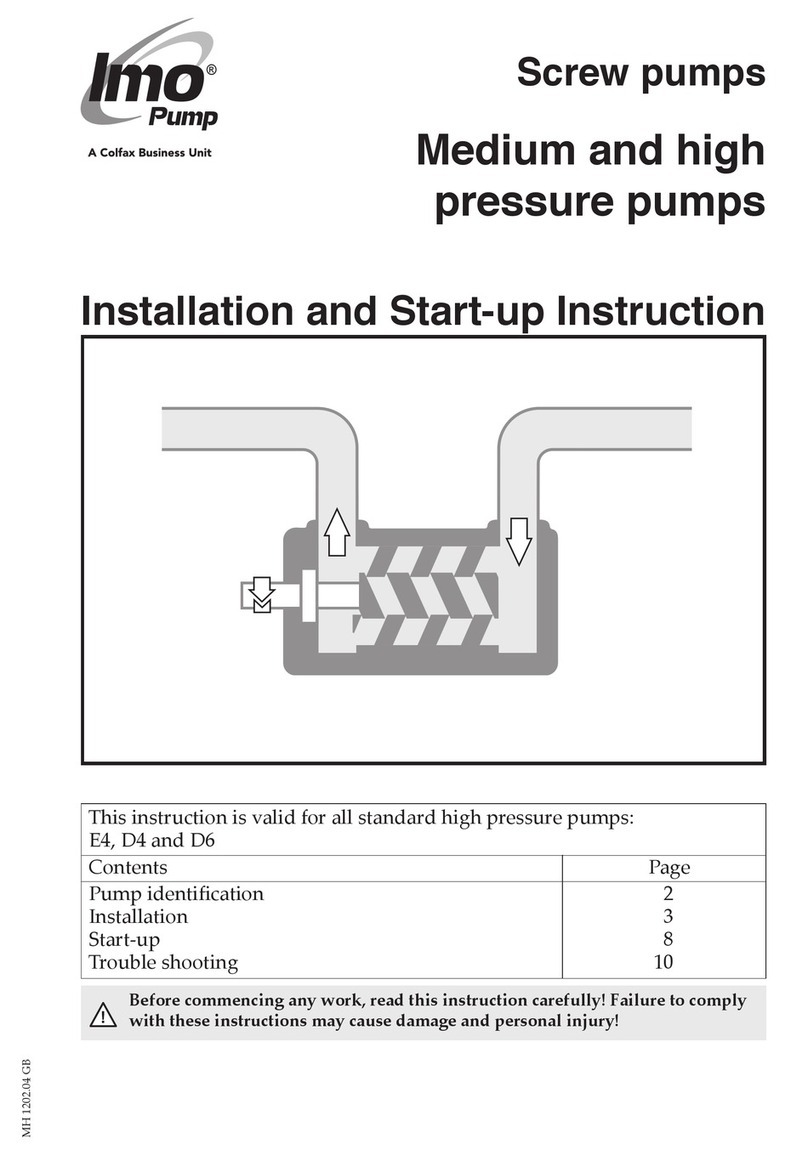
4LPD 0604GB
March 2002
IMO AB, Telephone: + 46 8 50 622 800, Telefax: + 46 8 645 15 09
!
!
!
!
!
!
If the pumps operating temperature ex-
ceeds 60°C let the pump cool off before any
service, maintenance or dismantling work
is commenced to avoid burn injury.
All work carried out on the pump has to be
performed in such a manner that risks for
personal injury are observed!
When handling liquids that may harm skin
use gloves and/or protective clothing.
When handling liquids which may involve
fire hazards appropriate precautions to
avoid danger are to be taken.
In case of failure for a system with elevated
pressure, fluid jets may cause injury and/or
damage.
Oil leakage may make the floor slippery
and cause personal injury.
Service intervals
The intervals for inspection and replacement of wear
parts vary greatly with the properties of the pumped
liquid and can only be determined by experience.
All internal parts of the LPD-pump are lubricated by
the pumped liquid. Pumping liquid which contains
abrasive materials, or liquid that is corrosive, will
significantly reduce service life and call for shorter
service intervals.
Wear in the pump may be indicated by:
• Vibration
• Noise
• Loss of capacity
• Reduction in flow/pressure
• Leakage
In installations where unplanned shut downs must
be avoided, it is advisable to have a complete pump
available for replacement, should any malfunction
occur. Furthermore we recommend planned inspec-
tion and overhaul at regular intervals, not exceeding
3 years.
It is recommended always to have the spares in-
cluded in minor spare part kit available.
Inspection of shaft seal
As the seal faces of a mechanical shaft seal are
lubricated by the fluid a certain leakage will always
be present. Ten drops per hour can be considered as
acceptable.
An external visual inspection of the pump is advis-
able at least every two days to assure that the shaft
seal is not leaking too much.
Excessively leaking shaft seals should be replaced
without delay, as the leakage normally will grow
worse and cause additional damage.
Follow the instructions in the dismantling/reassem-
bly session.
When working with a shaft seal, cleanliness is of
utmost importance. Avoid touching the seal faces. If
necessary, the seal faces should be cleaned immedi-
ately prior to assembly, using a dustfree cloth and
clean solvent.
Never use grease on the seal faces.
O-rings
All O-rings found to be hard or damaged shall be
replaced.
Inspection of rotors
If an indication of a worn pump is noticed (see
service intervals above), a brief inspection of the
idler rotors is recommended.
A quick inspection of the idler rotors can be made
simply by removing the rear cover. Note that the
driver must be deenergized and the pump hydrauli-
cally isolated before the rear cover is removed.
Internal clearances in the pump, which are vital for
its proper function, may have been affected by wear.
Acceptable wear can be determined only by experi-
ence of the actual application. As a rule of thumb the
following max clearance values may apply:
• Between rotor and bores or bushings: 0.2 mm
• Between rotor flanks: 0.4 mm
For light duties (low pressure, medium viscosity)
even bigger clearances may be acceptable but for
low visc./high pressure duties the limit will be
lower.
Also check if there are major scratches on these
parts.
If a more thorough investigation is needed, proceed
as under ”Dismantling and reassembly”.
ATTENTION
Use appropriate vessels to collect oil spillage
when removing and opening the pump.






























